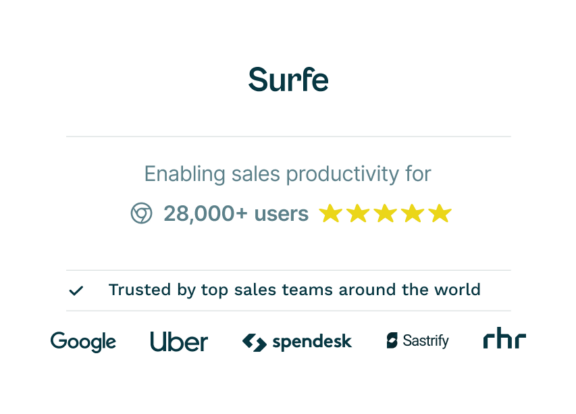REVEALED: The Top 10 Email Finder Tools for 2025

Finding accurate email contacts is as crucial to a sales team as a compass is to a ship’s crew navigating uncharted waters. It’s the backbone of lead generation, the secret sauce of outreach success, and the difference between hitting quota or missing it.
As sales professionals come under more pressure to perform, and are increasingly pressed for time, email finder tools can be the wingman every sales rep needs to zero in on their perfect prospect. These tools help teams reach the right contacts efficiently by automating the process of finding accurate emails, empowering sales to focus on what they do best: building relationships and closing deals.
To help you evaluate the best of the bunch while planning your budgets for 2025, we put several popular email finder tools to the test to see which ones truly stand out. We provided each tool with an identical list of contacts to test the waters. Two metrics guided our evaluations: the “Find Rate,” which measures the initial success in locating email addresses, and the “Real Find Rate,” which indicates the confirmed accuracy of these emails.
Let’s dive into the findings and see which tools sailed smoothly and which struggled with the tides. Need to skip ahead? In this article, we’ll cover:
How We Tested the Tools
We focused on evaluating two distinct categories of email finder tools to help you understand what you need to level up your prospecting game in 2025:
- Waterfall Enrichment Tools: These tools enrich contact information by layering data from multiple sources, providing a broader dataset that may include job title, company info, social media links, and more.
- Individual Email Finders: These tools focus on one thing—finding an email address. They tend to be straightforward, fast, and are ideal for sales professionals whose main concern is reaching the right person efficiently.
Each tool was given the same list of 2,000 contacts to ensure a fair comparison, and two critical metrics were used to rank them:
- Find Rate: Measures the initial rate of success in locating an email address for a given contact.
- Real Find Rate: Represents the accuracy of these emails after verification, showing how many of the emails located were actually valid.

Waterfall Enrichment vs. Individual Finders: Which One Do I Need?
Waterfall Enrichment Tools
Imagine Waterfall Enrichment Tools as a symphony conductor: they harmonize data from multiple sources to enrich contact information. They don’t just give you an email; they layer in additional information, often going deeper into the specifics of each contact, and they do so by “cascading” down through multiple databases and sources to ensure the contact data is as accurate as possible.
Individual Email Finders
Individual Email Finders, on the other hand, are like precision snipers, laser-focused on one goal— finding that email address. They don’t enrich the contact with extra details; instead, they’re all about accuracy and efficiency, providing quick and often accurate emails without the frills.
So, which providers come out on top for each category? Let’s find out.
Ranked List of Waterfall Enrichment Tools
1. Surfe
- Find Rate: 97%
- Real Find Rate: 76%
Strengths: Surfe came out on top in the waterfall category, achieving the highest Find Rate of 97%. Not that we’re biased, but Surfe’s robust data enrichment capabilities, which pull information from multiple sources to provide a comprehensive profile of each contact, can be a real blessing for SDRs looking to get in front of key stakeholders. With Surfe, you can use over 15 databases in just one search to get the right details for your outreach campaigns.
Integration Benefits: Partnering with major CRM systems like HubSpot and Pipedrive, Surfe can neatly fit into your existing tech stack to save you precious admin time. Once a prospect’s email is located, the contact information can be immediately synced with existing workflows so you can get to work on dazzling them with your perfectly-crafted communications. When you connect Surfe to your CRM, you can see the full sales journey from prospect to customer to better understand how your strategy is performing.
Drawbacks: Surfe’s Real Find Rate sits at 76%, which is solid: but you might want to build out your workflow with additional verification tools to ensure your emails are really reaching inboxes.
Use Case Example: Surfe is perfect for teams focused on Account-Based Marketing (ABM) or enterprise-level outreach, where understanding the full context of a contact’s role and company dynamics is just as valuable as having the email itself. Consider a sales team targeting executives across several industries. By using Surfe, they can quickly access detailed profiles for each contact, helping them customize outreach for better engagement rates.
2. FullEnrich
- Find Rate: 94%
- Real Find Rate: 83%
Strengths: Fullenrich is a data-heavy tool that excels in providing deeper enrichment, especially valuable in specialized sectors. With a Find Rate of 94%, it’s highly effective at locating emails. However, what sets Fullenrich apart is its Real Find Rate of 83%, meaning most of the emails it finds are confirmed as accurate.
Niche Advantage: Fullenrich is well-suited for industries requiring comprehensive data, such as B2B technology or finance. It offers detailed insights into each contact’s professional background, making it easier to segment leads and craft more targeted pitches.
Drawbacks: Fullenrich lacks some integration capabilities with CRM systems, which could slow down workflows for teams who want a seamless workflow, without tab-hopping. This can also mean that teams need to spend more time on manual data entry tasks, which opens you up to human error and time wastage.
Use Case Example: A tech sales team needing to reach decision-makers in niche markets would benefit from Fullenrich’s accurate, enriched data. They gain not only email addresses but also specific insights that help build personalized outreach strategies.
3. BetterContact
- Find Rate: 92%
- Real Find Rate: 80%
Strengths: BetterContact is fast, efficient, and stands out for its high Real Find Rate, confirming that 80% of the emails it finds are accurate. Its Find Rate of 92% means it doesn’t lag far behind the top competitors, and it integrates directly with Surfe, allowing for even more versatile workflows.
Drawbacks: BetterContact’s Real Find Rate slightly lags behind other waterfall enrichment tools on the market, so sales professionals may need to verify contacts in critical campaigns. But for general prospecting needs, BetterContact can be a good choice for teams looking to get the job done.
Use Case Example: A sales team needing to conduct quick outreach across a large number of contacts, such as for product announcements, could use BetterContact for efficient, accurate contact generation.
| Tool | Find Rate | Real Find Rate | Integrates with Surfe |
| Surfe | 97% | 76% | Yes |
| Fullenrich | 94% | 83% | No |
| BetterContact | 92% | 80% | Yes |
Ranked List of Individual Email Finder Tools
1. Apollo
- Find Rate: 93%
- Real Find Rate: 70%
Strengths: Apollo secured the highest Find Rate among individual email finders at 93%. Its efficiency and speed make it particularly popular for high-volume outreach. The tool also integrates with Surfe, giving users the flexibility to leverage Surfe’s enriched contact data when needed.
Drawbacks: With a Real Find Rate of 70%, Apollo is reliable but may require additional verification for accuracy-critical campaigns.
Use Case Example: A sales team with a goal to reach thousands of potential leads in a short time could benefit from Apollo’s speed. For example, it’s ideal for event follow-ups where quick, broad outreach is needed.
2. Anymail
- Find Rate: 91%
- Real Find Rate: 75%
Strengths: Anymail’s Find Rate of 91% positions it close to Apollo, while its Real Find Rate of 75% adds a layer of reliability for those looking for verified contact information. It’s known for its quick and straightforward results, making it a favorite among teams prioritizing speed.
Drawbacks: Anymail does not integrate directly with CRM systems, so users may need to manually import data, which could be time-consuming.
Use Case Example: For a sales professional focusing on cold outreach in the e-commerce space, Anymail can quickly populate contact lists for tailored email campaigns, facilitating faster lead generation.
3. Findymail
- Find Rate: 90%
- Real Find Rate: 78%
Strengths: Findymail is unique in its ability to locate emails based on minimal information, like a name and website. Its Find Rate of 90% and Real Find Rate of 78% make it a well-rounded option that balances speed with accuracy. Sales professionals who know the company but not the specific contact’s details may find this tool especially useful.
Drawbacks: Findymail has limited integration capabilities beyond syncing to your CRM, which could make workflows less efficient for teams who like to use a variety of verification tools to get the best results.
Use Case Example: For niche sales teams focusing on specific contacts at known companies, Findymail provides targeted accuracy, helping them zero in on the right person for outreach.
4. DropContact
- Find Rate: 87%
- Real Find Rate: 72%
Strengths: Known for its innovative algorithms, DropContact is adept at finding emails that may be harder to locate through traditional databases. It has a respectable Find Rate of 87% and a solid Real Find Rate of 72%, which is impressive for the harder-to-find email niche. DropContact can also be integrated with Surfe, so it’s a win-win if you want to use features like our personalized message templates for LinkedIn and InMail.
Drawbacks: DropContact’s relatively low Find Rate compared to top competitors may be a limiting factor for high-volume prospecting.
Use Case Example: For a business development team targeting hard-to-reach executives, DropContact is effective for uncovering elusive contact information that other tools may overlook.
5. Snov.io
- Find Rate: 86%
- Real Find Rate: 52%
Strengths: Snov.io combines versatility with efficiency, making it popular among smaller teams with varied needs. Although its Find Rate is at 86%, its Real Find Rate of 52% suggests it may require additional verification steps, especially for outreach where email accuracy is paramount.
Drawbacks: With a lower Real Find Rate, Snov.io may be less ideal for campaigns requiring strict accuracy, such as outreach targeting high-value clients.
Use Case Example: Ideal for small or early-stage teams conducting broad outreach, Snov.io helps quickly populate lists for wide-reaching campaigns.
6. Enrow
- Find Rate: 85%
- Real Find Rate: 77%
Strengths: Enrow’s Real Find Rate of 77% gives it a higher accuracy compared to some competitors. Its 85% Find Rate isn’t the highest, but Enrow is valued for its reliability and data sourced from verified points, making it a trusted tool for accurate outreach.
Drawbacks: Enrow doesn’t quite stand up to some competitors with its integration capabilities (you can’t use it with Surfe, yet, for example). So you might end up finding your team spending more hours on admin and manual data entry tasks.
Use Case Example: A B2B sales team that depends on verified data would find Enrow’s high Real Find Rate particularly useful, as it aligns well with high-stakes outreach efforts in industries where first impressions really matter.
7. Hunter
- Find Rate: 84%
- Real Find Rate: 70%
Strengths: Hunter is well-known for its ease of use and consistent performance. While its Find Rate of 84% and Real Find Rate of 70% may seem a little modest in comparison to some of the other tools in our rankings, Hunter’s value lies in its straightforward functionality and reliability for general prospecting.
Drawbacks: With a slightly lower Find Rate than competitors in the high-volume space, Hunter works best when combined with other tools like Surfe to gather more contact data.
Use Case Example: For sales professionals in startups or smaller teams, Hunter is efficient for general prospecting and allows for broad outreach across various industries.
| Tool | Find Rate | Real Find Rate | Integrates with Surfe |
| Apollo | 93% | 70% | Yes |
| Anymail | 91% | 75% | No |
| Findymail | 90% | 78% | No |
| DropContact | 87% | 72% | Yes |
| Snov.io | 86% | 52% | Yes |
| Enrow | 85% | 77% | No |
| Hunter | 84% | 70% | Yes |
How to Choose the Right Tool For Your Team
Choosing the best email finder tool in 2025 is all about aligning the tool’s strengths with your sales team’s needs, outreach goals, and workflow preferences. So, what should you consider when making the final call?
1. Assess Your Outreach Goals
Start by understanding your outreach goals. If your team prioritizes a high volume of contacts with minimal data enrichment, individual email finders like Apollo or Anymail may be the right fit. These tools excel in Find Rates, making them ideal for broad outreach. However, if a nuanced, deeply enriched contact profile is more valuable— like in B2B tech sales— then consider waterfall enrichment tools such as Surfe or Fullenrich, which layer data for more targeted approaches.
2. Balance Speed and Accuracy
Tools with high Find Rates are attractive for quick outreach, but Real Find Rate (accuracy) is essential for avoiding bounces and wasted resources. If accuracy is essential for maintaining your brand reputation, focus on tools which scored impressively in Real Find Rate. On the other hand, for campaigns where speed trumps precision, opt for tools like Apollo, which maximizes outreach efficiency. By balancing both metrics based on campaign demands, you can increase engagement without sacrificing too much speed or accuracy.
3. Consider CRM and Workflow Integration
Tools that integrate well with CRMs streamline workflows and help maintain clean, centralized data. Surfe, which integrates with popular platforms, allows for seamless transition of contact data to your CRM, reducing manual input and keeping pipelines organized. For teams heavily invested in CRM-based outreach, ensure that your chosen tool fits neatly into your existing tech stack.
4. Choose Based on Industry-Specific Needs
Different industries may benefit more from certain tools. For example, sales teams in competitive sectors like finance may prefer tools with high accuracy and enriched data to make their outreach highly targeted. Sectors that demand high volume, such as e-commerce or SaaS, may prioritize Find Rate and CRM compatibility for fast prospecting and automated follow-ups.
5. Test and Learn
Finally, trial runs can reveal which tool genuinely fits your team’s flow. Many email finders offer trial periods or scaled-down versions, so you can compare a few options on smaller datasets before making a full commitment. Testing real and Find Rates in your environment can give insight into how these tools perform under your unique requirements.
Let’s Wrap it Up!
It’s no secret that email finder tools are indispensable for efficient and accurate outreach– they can be your sales firepower. But picking the right weapon requires you to know how your own team works best, and what kind of industries you’re looking to target.
Waterfall Enrichment Tools like Surfe and Fullenrich offer broader data enrichment, making them ideal for sales teams that need more than just email addresses. While individual email finders like Apollo and Anymail provide focused solutions, perfect for fast-paced outreach needs.
When choosing an email finder tool, keep in mind the importance of both Find Rate and Real Find Rate. A high Find Rate is crucial for reaching more contacts, but a high Real Find Rate will ensure you’re reaching the right ones.
So, as we look forward to 2025, weigh up the needs of your team carefully: whether it’s volume, speed, or enriched data, there’s an email finder on this list ready to elevate your outreach game.
You’ve got the specs, now choose your fighter!

Ready to revolutionize your propsecting efforts for 2025?
Surfe’s Find Rate of 97% is the best in the business, and we’ve got the stats to prove it.
Frequently Asked Questions (FAQs)
What is the difference between “Find Rate” and “Real Find Rate”?
Find Rate measures how often an email finder tool can locate an email address in the initial search, while Real Find Rate reflects the accuracy or validity of the found emails, indicating how many emails are confirmed as deliverable. Both rates are essential: a high Find Rate is great for reaching more leads, but a high Real Find Rate ensures these leads are accurate and won’t bounce.
Why are Waterfall Enrichment Tools better for Account-Based Marketing (ABM)?
Waterfall Enrichment Tools go beyond finding email addresses— they also pull in rich data like job roles, industry-specific details, and organizational insights. These features make them ideal for ABM, where understanding each contact’s position and context within a company is essential for targeted, high-value outreach.
Which tools are best for high-volume prospecting?
Individual Email Finder tools like Apollo and Anymail are well-suited for high-volume prospecting. They focus on delivering fast, accurate email addresses, which is critical for sales teams that prioritize volume in their outreach strategy. These tools provide reliable data without extensive enrichment, making them efficient for quick contact acquisition.
How should sales teams decide between an enrichment tool and a dedicated email finder?
The choice depends on your outreach needs. If your team requires quick access to verified email contacts, a dedicated email finder may be best. For teams that value deeper contact context— such as company background or industry insights— a waterfall enrichment tool provides added data that can help you tailor a personalized outreach strategy to suit your market.
What are the limitations of using an email finder tool, even with high accuracy?
While email finders are powerful for prospecting, they’re not foolproof. Even tools with high Real Find Rates might occasionally return outdated or incorrect emails, especially in dynamic industries. It’s often a good idea to cross-validate high-value leads in particular, or integrate email validation processes into your workflow to avoid costly lost leads.


